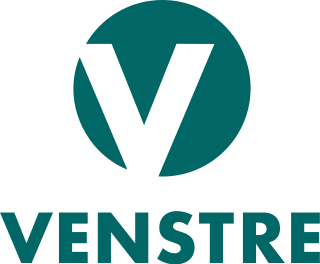
Venstre, full name Venstre, Danmarks Liberale Parti, is a conservative-liberal, agrarian political party in Denmark. Founded as part of a peasants' movement against the landed aristocracy, today it espouses an economically liberal, pro-free-market ideology.
The Liberal People's Party was a social liberal political party in Norway, established by a split in the Liberal Party over the issue of Norway's accession to the European Economic Community in 1972. The party was originally called the New People's Party until changing its name in 1980.

Johan Sverdrup was a Norwegian politician from the Liberal Party. He was the first prime minister of Norway after the introduction of parliamentarism and served as the fourth prime minister of Norway. Sverdrup was prime minister from 1884 to 1889.

This article gives an overview of liberalism and radicalism in Denmark. It is limited to liberal and radical egalitarian parties with substantial support, mainly proved by having had a representation in the parliament. The sign ⇒ denotes another party in that scheme. For inclusion in this scheme it isn't necessary so that parties labeled themselves as a liberal party.

The Liberal Party is a centrist political party in Norway. It was founded in 1884 and it is the oldest political party in Norway. It is positioned in the centre on the political spectrum, and it is a liberal party which has over the time enacted reforms such as parliamentarism, freedom of religion, universal suffrage, and state schooling.

The Social Liberals is a minor social liberal political party in Austria. It has never won a seat in a federal election.
The Moderate Liberal Party was a political party in Norway that emerged from the moderate and religious branches of the Liberal Party in 1888. The party's turn towards cooperation with the Conservative Party caused a party split in 1891, eventually sharpening its profile as a moderate-conservative party based among the low church of south-western Norway. The party was dissolved shortly after the dissolution of the union with Sweden in 1905.
The Coalition Party was a Norwegian political coalition drawn from the Conservative Party, the Moderate Liberal Party and independent Liberals. Its main issues were opposition to the Liberal Party's political union radicalism, as well as to the rising growth of social democracy. Originally formed to pursue a more careful negotiating line towards Sweden, the party turned around and took part in Michelsen's Cabinet, which carried through the dissolution of the union between Norway and Sweden in 1905. The coalition's leading members included Christian Michelsen himself, Wollert Konow (SB) and Bjørnstjerne Bjørnson.
The Free-minded Liberal Party was a political party in Norway founded in 1909 by the conservative-liberal faction of the Liberal Party. The party cooperated closely with the Conservative Party and participated in several short-lived governments, including two headed by Free-minded Prime Ministers. In the 1930s the party changed its name to the Free-minded People's Party and initiated cooperation with nationalist groups. The party contested its last election in 1936, and was not reorganised in 1945.
The Market towns of Nordland, Troms and Finnmark was an electoral district for parliamentary elections in Norway. It comprised the market towns of Bodø and Narvik in Nordland county, Tromsø in Troms county and Hammerfest, Vadsø and Vardø in Finnmark county.
The Market towns of Østfold and Akershus counties was an electoral district for parliamentary elections in Norway. It comprised the market towns of Fredrikstad, Halden, Moss and Sarpsborg in Østfold county and Drøbak in Akershus county.
The Market towns of Sør-Trøndelag and Nord-Trøndelag counties was an electoral district for parliamentary elections in Norway. It comprised the market towns of Trondheim in Sør-Trøndelag county and Levanger in Nord-Trøndelag county.
The Market towns of Vest-Agder and Rogaland counties was an electoral district for parliamentary elections in Norway. It comprised the market towns of Flekkefjord, Kristiansand and Mandal in Vest-Agder county and Haugesund and Stavanger in Rogaland county.
The Market towns of Hedmark and Oppland counties was an electoral district for parliamentary elections in Norway. It comprised the market towns of Hamar and Kongsvinger in Hedmark county and Lillehammer and Gjøvik in Oppland county.
The Market towns of Telemark and Aust-Agder counties was an electoral district for parliamentary elections in Norway. It comprised the market towns of Brevik, Kragerø, Notodden, Porsgrunn and Skien in Telemark county and Arendal, Grimstad and Risør in Aust-Agder county.
The Market towns of Buskerud county was an electoral district for parliamentary elections in Norway. It comprised the market towns of Drammen, Hønefoss and Kongsberg in Buskerud county.
The Market towns of Vestfold county was an electoral district for parliamentary elections in Norway. It comprised the market towns of Holmestrand, Horten, Tønsberg, Sandefjord and Larvik in Vestfold county.
The Market towns of Møre og Romsdal county was an electoral district for parliamentary elections in Norway. It comprised the market towns of Kristiansund, Molde and Ålesund in Møre og Romsdal county.





